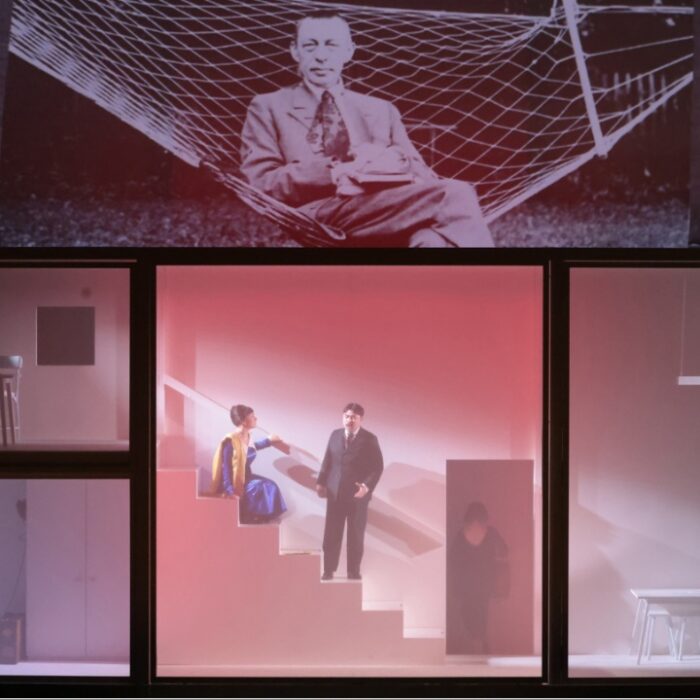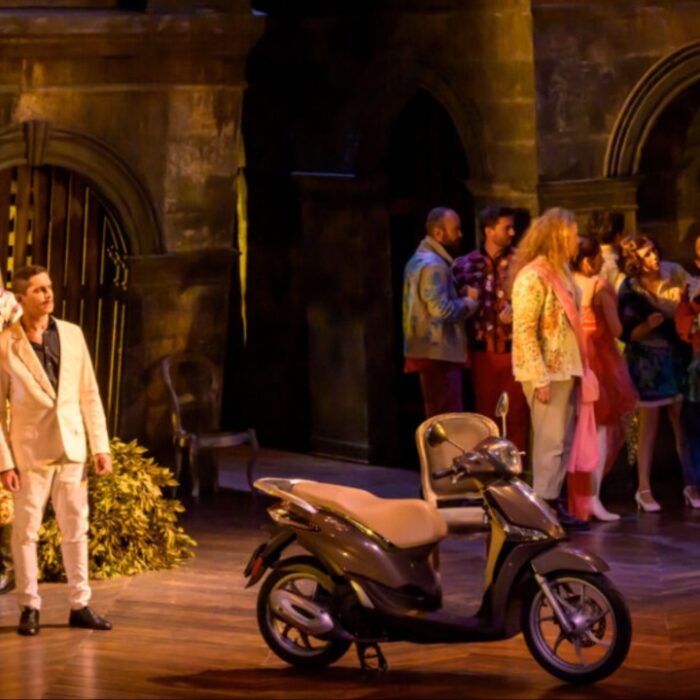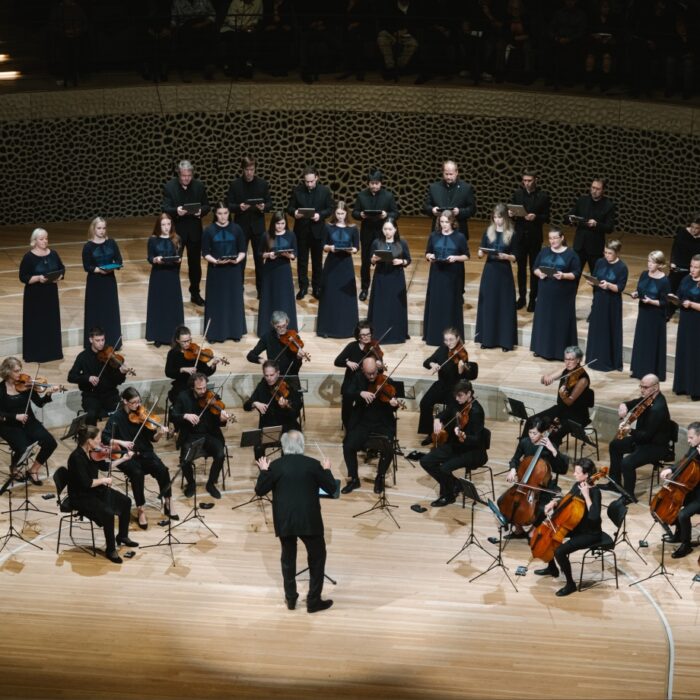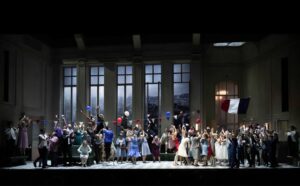
Festival Aix-en-Provence 2025 Review: Louise
Soprano Elsa Dreisig as Louise Gives Stellar Performance in Christof Loy’s Disappointing Production
By João Marcos CopertinoFull disclosure: my definition of purgatory is a Christof Loy opera staging. They are not infernal—there is always some redemption—and they used to be good. But now, they are definitely not for me. That mono-scenario, that preference for milk-aisle lighting and the somewhat surreal stagings. I get it, some people might like it. I am even friends with some of them. But for me, Loy’s current work never expresses an aesthetic. It is an imitation of aesthetics, void of proper meaning. And in this “Louise,” we also face a big issue in Loy’s productions: his moralistic misogyny.
When the Aix-en-Provence Festival scheduled Gustave Charpentier’s “Louise” (not an opera, per se, but a “musical novel”), I fretted about why such an underperformed opera would be consigned to Loy and not to someone more exciting. I understand that Loy has many fans—and he has done much admirable work in the past—but popularity is never a good marker of quality, especially in the opera world. In the end, after surviving the first two acts, I found that Loy actually does get a few things right in the middle of the opera—though only in the middle.
Today, a lesser-performed title, “Louise,” is mostly known for its aria “Depuis le jour”—sung by all great sopranos nowadays and even the driving force behind the cult film “Diva.” The fact is that, even though, musically the opera reaches the sublime only in the third act, “Louise” is a rather complex operatic work that has a place in the repertoire because of its idiosyncrasies and compelling plot.
“Louise” is a blend of a naturalist novel and an almost surreal Freudian nightmare, rendered with that French class and finesse that marked the end of the fin-de-siècle music. The absence of the full opera in the schedules of major opera companies is a pity because it deprives us of seeing how intellectually daring and vast the operatic form was in the 1900s—a genre clearly in crisis, but a very profitable one.
Another aspect of “Louise” is how, in a certain way, it prefigures the impressionist “Pelléas et Mélisande” that would open at the same opera house, the Opéra-Comique, a few years later. Although one is a “naturalist” opera and the other “surreal,” they both share similar topics, especially in the treatment of their female protagonist: a soprano trapped in a relationship with a father figure (or in the case “Louise” her father) has that relationship disrupted by a youthful love for a tenor. While most operas are, according to Machado de Assis, the story of the tenor’s love for the soprano, disrupted by the baritone, “Louise” enters in a much deeper way into the psychological dramas of this—justifying its claim to be a “musical novel.”
Also, it is noticeable that the people who complained about the misogyny in the plot of “Pelléas” were the very same people who eagerly told me that “Louise” is “an anti-woman opera.” They are not fully wrong—but if we started to count up all the anti-women operas, the list might be longer than a thousand and three. Moreover, merely to vilify problematic operas prevents one from confronting what in them actually opens the possibility of questioning their own most problematic assumptions. Read attentively, “Louise,” like “Pelléas,” puts in question the very structures of patriarchy it enacts.
But it is true that, in “Louise,” the main protagonist’s freedom relies first and foremost on her affiliation with a man—be it her lover or her father. Even though in her relationship with her lover—and her fascination with Paris—she aspires to a certain level of personal and sexual freedom unheard of in most of the repertoire, it is hard not to view such dreams, and their naïveté, with some condescension.
Last year, Aix revived the lavish Mitchell production of “Pelléas,” in which the English director did everything possible to emphasize the surrealism of the opera—and to circumvent its misogyny. Now, Loy seems a mere uninspired copy of that—without the political and intellectual gains of the former.
All the opera’s action happens in a waiting room—most likely a 1950s gynecological clinic (perhaps where women get abortions, though they leave the doctor’s office seeming more lobotomized than anything). The staging takes the idea of “rêve” (dream) in Charpentier’s libretto very literally—it is evident that we are all within Louise’s hallucinating imagination—a kind of directorial gimmick that is used too much nowadays and with too little success. It is, after all, an attempt of making operatic natural’s plural form of narration, into a first-person perspective, in which we cannot trust our eyes.
Within the confines of her frail mind, Louise revisits (or invents) her abusive mother and her differently abusive father. In her household, she is at once infantilized and fetishized. The contrast is with Julien, who eroticizes her and understands her sexualization as part of her freedom—that is why, during their emblematic love duo in the third act, the chorus sings “Libres.” Love and non-incestuous sex are indissociable from freedom in Charpentier’s work.
In Loy’s vision of the opera, however, there is a level of moralism and misogyny that is even more retrograde than the original “Louise” production. While in the libretto, Charpentier makes Louise’s final break with her parents a traumatic event, it is not necessarily a punishment to the protagonist—she indeed goes on to live a free urbanite life—she will be sexually active, though not necessarily married. What happens in the libretto is simply the acceptance that the creation of the self and the pursuit of desire might imply a deviance from paternal values and the home.
Loy, proving himself a moralist of the lesser kind, makes the final scene a defeat for Louise—she eagerly confesses her desire for the city and Julien while fully performing the incestuous sexual acts that the opera once only suggested. It is also an inversion of the worst kind: Louise is the one physically seeking her father—as if her cardinal offense had been her desire for incest, and not the contrary, as if it were not her father who abused and oppressed her. Such a change, though it creates the superficial impression of dissent, actually impoverishes the experience—showing a frail understanding of moralism and fate in opera.
I can see that what Loy was seeking was to make explicit the psychoanalytical conflict of the opera’s plot—but in such a mannered and shallow way, that it is hard not to be embarrassed. Moreover, what he actually achieved was the undoing of Louise as a real character. As much as Loy has a tendency to imitate beauty without ever creating it, his Louise imitates the gestures and behaviors that a real modern character would have. To me, such a solution seems a bit superficial of the psychoanalytical familial drama, and reveals more about the regisseur’s political wishes than necessarily of the character’s psyche.
I am perfectly aware Loy is celebrated, that Loy is creative, that Loy is beloved—but Loy is also a misogynist. I usually avoid this kind of name-calling in music criticism, because it often reduces the critical appraisal of an artist—(“he or she is that, therefore he cannot be good” is the most common form of attack in art criticism nowadays). That is not the case here, Loy is not untalented, and people can feel perfectly free to enjoy his work (who am I to say that they cannot?). But his staging has a strong vision: anti-women—and that must be said too. It is a rare case that the opera might not be an “undoing of women,” but actually the staging. And I think it is fair to say that his own misconception diminished the potential quality of his work. Also, it is more than fair to stress that his team is fully white and masculine. We might talk about diversity on the stage, but Loy has the quintessential non-diverse backstage (like the Vienna Philharmonic circa 1989).
Perhaps in the past, I might have enjoyed his work (it is my purgatory, not my hell). I spent the night and the day after the performance revisiting some of his former stagings, and most of the things that intellectually underwhelmed me this time were more or less present in the past (from the infamous case of the Royal Opera House’s “Ariadne auf Naxos” that did not hire Deborah Voigt because of the little black dress thing, to the dull but mostly innocuous “Orfeo ed Euridice” in Salzburg). I also searched to see a couple of older productions of “Louise.” I was impressed to see that André Engel’s staging of the opera in 2007 was visually more impressive—and even more modern-looking—than Loy’s, even though it was premiered almost two decades ago. Perhaps a revival would be welcome. What mesmerizes me is how one of the most popular operas in the 1900s can still keep its spark (both musically and scenically). It cannot do so, however, in a production that does not embrace what Charpentier actually did right.
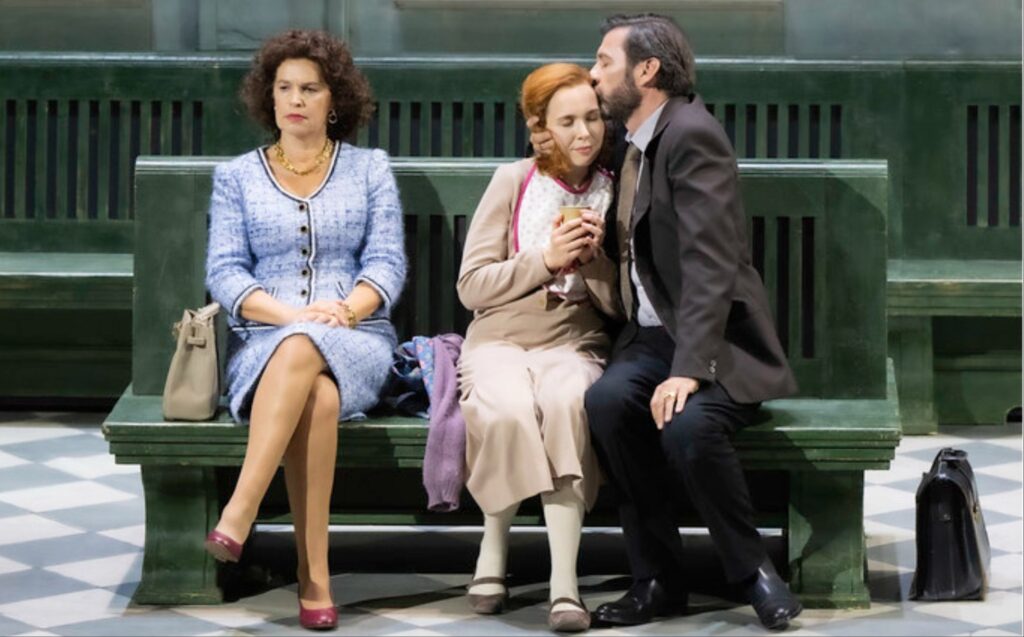
(Photo: Monika Rittershaus)
Cast Highlights
The night’s star was, of course, Elsa Dreisig. The French-Danish soprano is a very singular singer. Beautiful, more than competent vocally, and scenically expressive, Dreisig can mutate into many characters, always preserving a certain sense of ingenuity and emotional pubescence. Part of her dramaturgical flexibility is linked precisely to this capacity to present herself always a bit too fresh in life, too sensitive to all the novelties in her life.
Vocally, Dreisig has a very particular lyric voice: extremely uniform in all registers, it feels like she can sing everything without any effort. Her French is always extremely smooth and expressive. Part of the odds of having such a well-rounded instrument is that Dreisig sometimes struggles to express things in other tones and voices. I was glad to see that, in order to sing the more “verismo-like” moments in the third and fourth act, she could find a sound (sort of parlato, sort of chesty) that conveyed this sense of threat that is so important in the middle of the scene.
Of course, it feels like Dreisig was born to sing “Depuis du Jour”–such idiomatic pronunciation, such delicate phrasal construction, and, most importantly, how smart she is in actually knowing when to command her dynamics with the orchestra. Some singers capture us through the sense of strength and effort; Dreisig does so through ease and listening to her is like sailing the most placid of seas; one never expects her to be capable of making any mistakes.
In the New York Times, Joshua Barone claimed one could not hear her voice well during the “Wagnerian” love duo of the third act. I do not know what Barone’s understanding of Wagnerian music or house acoustics is—perhaps he sat too close to the stage, where voices do sound a bit less voluminous. What I can say is that I had no problem hearing any voice from the middle of the parterre—nor did my sources in the balcony of the house. In fact, I hardly face struggles with acoustics when in the Théâtre de l’Archeverdé…
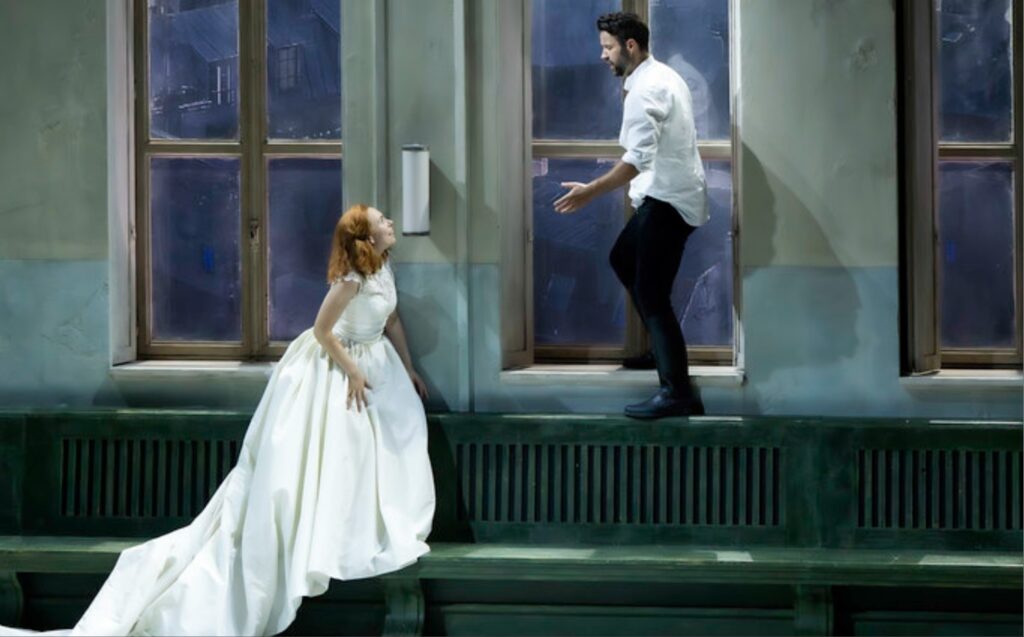
(Photo: Monika Rittershaus)
Julien and the night owl stroller role were blended into one, and both sung by Adam Smith. The singer has built a certain career in Aix—and elsewhere—as the leading “trash boy” lover tenor. A certainly problematic Pinkerton in last season’s “Madama Butterfly,” he is now a little better able to show his qualities, even though we can also perceive his frequent vocal inconsistencies.
First, Smith is not a bad actor. He has a young congressman kind of attractiveness that works well on this stage. The problem is his irregularity as a singer. On the one hand, he really tries to sing with as much nuance and risk as possible—if Dreisig is the kind of singer that makes us calm, Smith is the kind that makes us nervous, which is not necessarily a bad thing. Some performers are very good at creating that “will they be able to do it?” kind of feeling. In its best incarnations we have those drastic singers such as Sondra Radvanovsky, Michael Spyres, and—why not—Maria Callas. But, Smith is a bit behind in terms of technique compared to these singers. There has not been a performance I have seen him in where he did not crack. On the last night—which was recorded and will be televised—he cracked in his very first entrance, trying to toy a bit in his long high A singing “oh cœur ami!” To be fair, it is a very complicated zone of the tenor voice, especially because a bar later he must sustain an F-sharp, right in the passaggio. Yet, it is not good for the tenor to crack, especially right at the beginning.
That said, Smith really takes risks, and he makes sure we can tell how effortful each phrasing decision is for him. It is a mode of performance. I, personally, do not find his voice as smooth as it could be. There is a lack of clarity that might somewhat compromise the beauty of his tone, but he is perfectly capable of using such a quality to his advantage when singing those seducer roles. Perhaps, were his voice clearer and brighter, his characterization would be less compelling, and we would see too much good in a man who is meant to be shady.
The great Sophie Koch is at the height of her “Fanny Ardant” grand dame phase. If the resemblance between the mezzo-soprano and one of France’s most consequential actresses was not evident before, in this staging, it is almost impossible not to see it—the clothing with a Chanel-matching suit, the slightly curly hair that goes no lower than her shoulders. I could not stop thinking: what Ardant film are we meant to be seeing? One thing is good: while the mother role is often characterized by a woman deprived of beauty, with Koch, there is much elegance—it even makes it harder to understand why she would be so jealous of Louise—it is basically a modernization of the Evil Queen trope.
Koch’s voice has changed much over the years. While her voice might have more stamina and power than before, especially in the mid to lower register, Koch does not have the same legato that a few years ago made her such a compelling Octavian and Charlotte. In fact, part of the dramatic appeal of her voice lies precisely in its graininess. She also fully embraced the text of the opera, making the diction and projection a certain aspect of her singing. We could hear all consonants as if they took longer, like a certain kind of French lady who seems reluctant to speak any vowel in a more open manner. Clearly a properly composed character.
Finally, the role of the father was sung by a still very jovial Nicolas Courjal. In many ways, it was interesting to see a jovial and even desirable father such as Courjal—with tattooed shoulders and golden necklaces. Perhaps in the masculinist fantasy of Loy, it is essential that the father look nice—even though he is evidently an abuser (an aspect that the staging does not shy away from).
My main issue with Courjal was that, while the singer has a sonorous voice and very good legato, he is that kind of bass that “covers” his sound very much, sounding darker and darker—certainly a certain mode of singing French music. In most of the opera, that sound was appealing, but I somewhat missed a bit more brightness and musical urgency in the final duo—where it became impossible to distinguish his comforting voice from his threatening one.
The Orchestra and Chorus of the Opéra de Lyon played exquisitely—as well as an opera house orchestra and chorus can be expected to perform. The musical direction of Giacomo Sagripanti was acute and efficient: never covering the singers, stressing Charpentier’s rich orchestration, especially the wind solos—and knowing perfectly well how to conduct the audience during the intense third act of the opera. It was that kind of good opera that almost dissolves itself in the memory, without any musical vanity.
It is always pleasant to revisit “Louise,” an opera that, though a bit faded in time, still has so much to offer and say. It is, however, still a pity to see how mediocrity and backwardness are often prized, even in the most avant-garde opera institutions—for reasons that we all know too well to even bother to spell out.
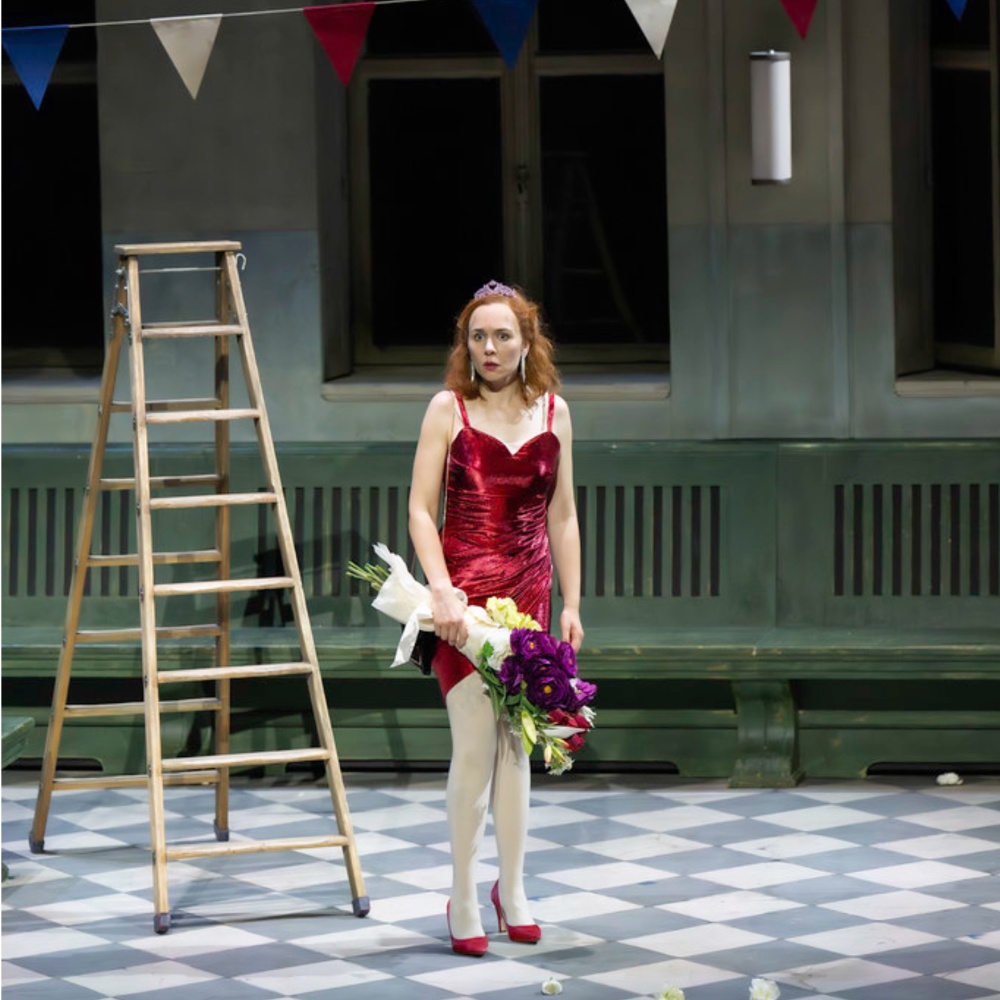
(Photo: Monika Rittershaus)
